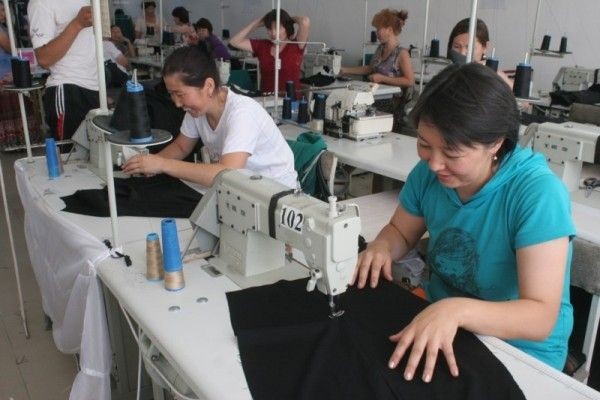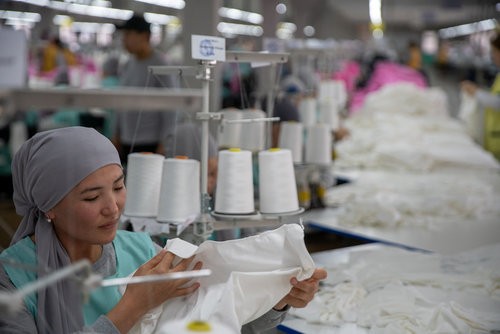BISHKEK (TCA) — A Textile and Clothing Week was held in Bishkek from November 7 to 16. It was the first large-scale event in the history of Kyrgyzstan devoted to the development of the textile and apparel sector. As part of the event, roundtables, a Fashion Week and a High Level Forum were held.
At the awarding ceremony, winners of competitions of young designers, industrial enterprises, craftsmen and the media were announced. An exhibition-fair of garments from local manufacturers took place, where local companies showcased their fabrics, clothes, shoes, and accessories.
The event was organized by the Kyrgyz Government, the Legprom Light Industry Enterprises Association of Kyrgyzstan, Fashion Designers Association of Kyrgyzstan, development partners including UNDP, EBRD, and ILO, and Russian-Kyrgyz Development Fund.
On November 16, a high-level Forum discussed how the State could support the industry to attract labor to the sector, improve the training system and ensure decent working conditions and tools for financing the clothing industry, as well as to enhance its export competitiveness.
At the end of the forum, its participants adopted a Resolution on the State’s measures to support the industry.
Priority sector
Textile and clothing production is among the priority sectors of Kyrgyzstan’s economy. The industry has a high export potential and is of special social significance for the country, as it creates mass jobs.
According to the National Statistical Committee, more than 45 thousand people are employed in the textile and clothing industry of Kyrgyzstan. Considering that many enterprises work in the shadow economy, the number of people employed in this sector, according to various estimates, ranges from 200,000 to 300,000. Over 90% of the sector’s workers are women.
The garment products rank third in Kyrgyzstan’s export. Over the eight months of this year, garment enterprises exported goods worth $157 million. According to the Economy Ministry, production of the clothing industry has increased by 15% over the past three years.
In terms of the volume of imported garment products to Russia, Kyrgyzstan ranks the fifth after China, Turkey, Italy, and Germany. This indicates high quality of Kyrgyzstan’s products.
Shortage of labor
The garment industry badly lacks personnel while the existing staff has low qualifications, said President of the Legprom Association Saparbek Asanov at the forum.
Most industry companies are located in Bishkek and near it, while the bulk of the workforce is available in rural areas, which results in a systemic gap in the human resources.
The problem of personnel outflow is related to a high level of migration of skilled and unskilled sewing workers to Russia. Russian companies offer better working conditions for employees, including wages and benefits. Young people prefer to go abroad to earn money to buy homes in Kyrgyzstan.
The average age of workers in the sewing industry is 35-40 years. Women in the garment industry mainly came to Bishkek from the regions and have problems with housing, access to healthcare and education services.
According to the Association of Light Industry Enterprises, there are over one thousand vacancies in the industry. Young people have no incentive, and they do not see any professional growth. On average, their salary is about 20-25 thousand soms. Due to the lack of incentive, young people are looking for work abroad.
The State should therefore create certain conditions and incentives for enterprises in the industry.
The Legprom Association asked the Government to consider the issue of mortgage lending for garment workers. This will help reduce migration, both internal and external.
Working in the shadow
According to the Economy Ministry, about 30 percent of light industry enterprises work in the shadow economy.
In Kyrgyzstan, seamstresses often move from companies in which the quality control of their products is carried out to the companies focused on quantity rather than quality. Most of these companies work in the shadow and undermine the reputation of the entire clothing sector, heads of large enterprises said.
Taking into account that a lack of finance is among the main problems of the industry, the Government is ready to ease the tax burden to remove the country’s clothing industry from the shadow, the Prime Minister said.
Suits from domestic producers
Prime Minister Mukhammedkaly Abylgaziev told the forum participants that he began to buy suits from local manufacturers this year, though he used to buy imported suits before he became Prime Minister.
“Right now I’m wearing a domestically-made suit,” he said.
Many high-ranking officials from other countries wear suits produced in their home countries and they often talk about it at various meetings. The Kyrgyz Prime Minister decided to adopt a good experience in promoting domestic products showing them during his business trips.
Domestic suits are cheaper than imported ones, but of high quality, Abylgaziev added.
Government to support the business
The Government intends to continue to support the garment business, pursue policies to expand exports and facilitate access to foreign markets, develop e-commerce, and raise production standards, Prime Minister Abylgaziev said at the forum.
He stressed the high creative potential of domestic designers and manufacturers of clothing products, who successfully represent the country at fashion shows in major cities of the world.
To support export-oriented enterprises, the Government will issue low-interest loans through the RSK Bank. The Government allocated 2 billion soms to the garment industry this year and plans to increase the amount in 2019.
The State also plans to provide the clothing industry workers with affordable housing. This year, 500 million soms were allocated from the national budget for the State Mortgage Company, Abylgaziev said. “We will task the Mortgage Company to develop a separate project for the sewers,” he added.
A system of preferential mortgage loans for 10-15 years will be introduced from 2019.
Expansion of capacities and production potential of the light industry is directly related to the training of its workers.
Created with the support of the Asian Development Bank, the Skills Development Fund has trained about 4,000 seamstresses, tailors and cutters over the last two years.
Restoring the light industry
The Government intends to restore the silk spinning factory in Osh in the south of the country, as well as to increase the production of cotton fabrics.
Kyrgyzstan’s garment and light industry was among the best in the Soviet Union. There was the Ministry of Light Industry with agro-industrial complexes. The Osh province harvested rich harvests of cotton, and local factories recycled it producing high-quality threads, fabrics and clothing. Large factories also produced woolen and silk fabrics but after the Soviet Union’s collapse they were destroyed.
The Government now plans to restore those plants, the Prime Minister said.
Forum recommendations
To ensure decent working conditions and reduce the outflow of labor force, the forum decided to develop measures of state policy focused on creating quality jobs, developing and implementing social and economic programs to support the sector through public-private partnership mechanisms including social housing, concessional lending, mortgage lending, and building of pre-school institutions. To make the training system effective, the needs of employers and the labor market should be analyzed and training programs brought in line with the needs of the labor market.
The State Tax Service and the Financial Police should step up work to remove sewing enterprises from the shadows and legalize them.








